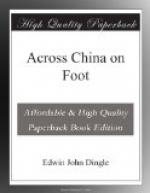I should like it to be known here, however, that I do not in any way whatsoever put myself forward as an authority on the question. I had not, at the time this was written, laid myself out to make any study of the subject. But the fact that I have lived in North-East Yuen-nan for a year and a half, and have traveled from one end of the province to the other, in addition to having come across tribes of people in Szech’wan, may justify me in the eyes of the reader for placing on record my own impressions as a general contribution to this most exciting discussion. I also lived at Shih-men-K’an (mentioned in the last chapter), among the Hua Miao for several months, traveled fairly considerably in the unsurveyed hill country where they live, and am the only man, apart from two missionaries, who has ever been over that wonderful country lying to the extreme north-east of Yuen-nan. One trip I made, extending over three weeks, will ever remain with me as a memorable time, but I regret that I have no space in this volume for even the merest reference to my journey.
Some of my friends in China might say sarcastically that mankind is destined to arrive at years of discretion, and that I should have known better than to include in my book anything, however well founded, of a nature tending to continue the wordy strife touching this vexed question of Mission Work, and that no matter how strikingly set forth, this is an old and obsolete story, fit only to be finally done with. It is for such to bear with me in what I shall say. There are thousands of men in the West who are entirely ignorant of men in China other than the ordinary Han Ren, and if I enlighten them ever so little, then this chapter will have served an admirable end.
In North-East Yuen-nan the tribes I came most in contact with were:—
(i) The Miao or Miao-tze, as the Chinese call them; or the Mhong or Hmao, as they call themselves.
(ii) The I-pien (or E-pien), as the Chinese call them; or the Nou Su (or Ngo Su), as they call themselves.




